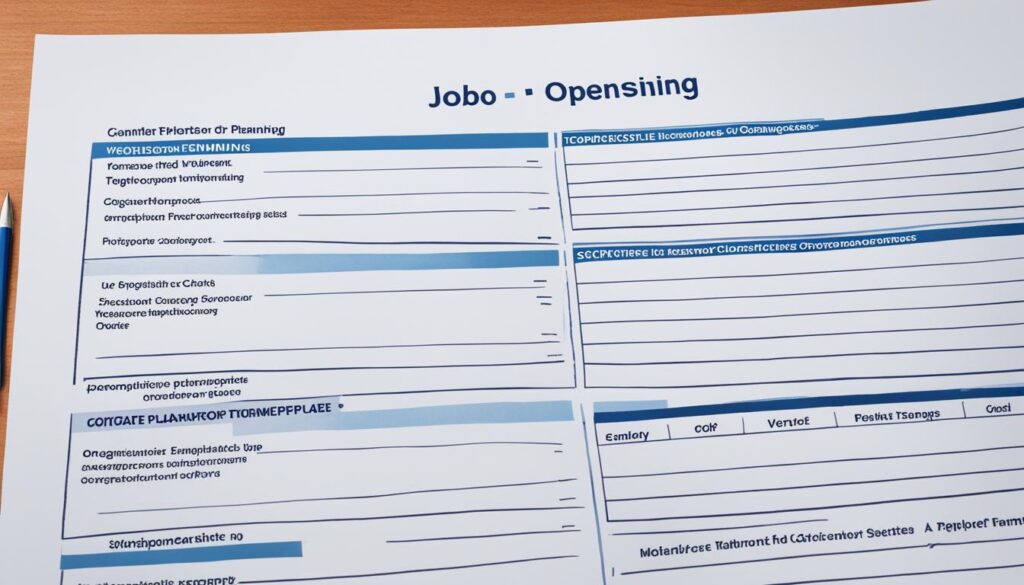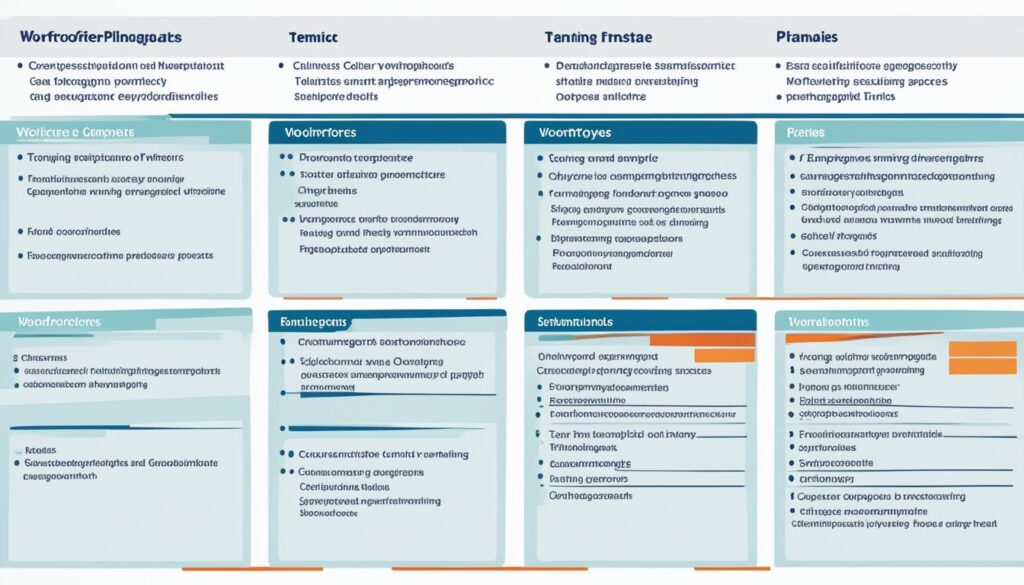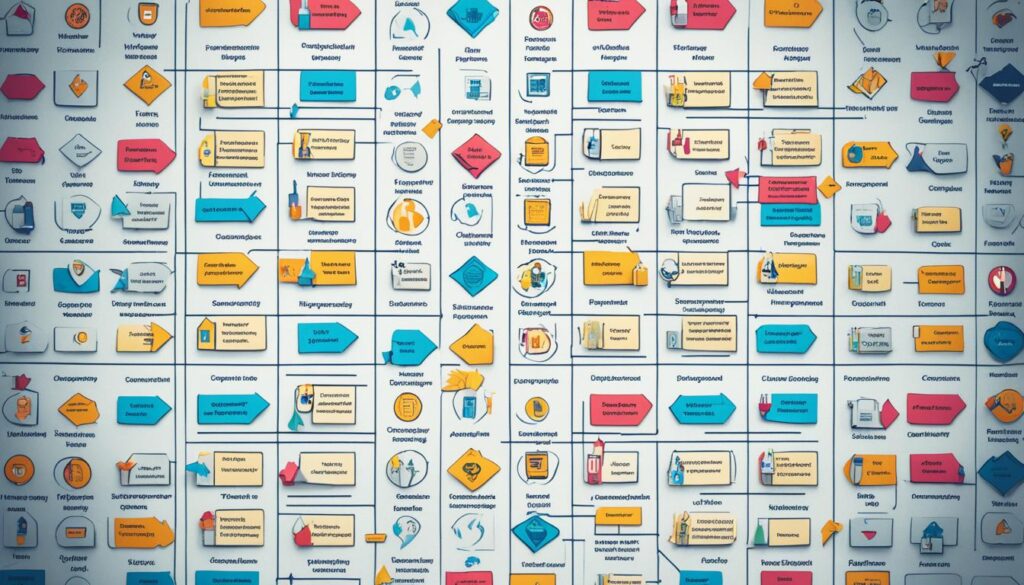Welcome to our article on how to optimize your HR strategies using a workforce planning template. In today’s fast-paced business environment, it is crucial for organizations to align their workforce with future goals and objectives. That’s where a workforce planning template comes in handy.
A workforce planning template serves as a comprehensive guide for businesses of all sizes, including small businesses, to evaluate their current employee status and identify areas for improvement. It offers valuable insights that enable you to make informed decisions about training, hiring, and succession planning.
By utilizing a workforce planning template, your HR department can optimize the talent management process and ensure efficient strategies that promote growth and success. With the right tools and templates, you can take control of your workforce planning and stay ahead of the competition.
In this article, we will explore the importance of a workforce planning template and how it can benefit your HR department. We will also provide you with a list of useful templates to streamline your workforce management process. Additionally, we will guide you on how to introduce a workforce planning template to your team and highlight the key benefits of incorporating it into your organizational practices.
So, if you’re ready to optimize your HR strategies and achieve long-term success, let’s delve into the world of workforce planning templates together. Stay tuned!
Why do you need a workforce planning template?
Workforce planning templates are essential tools for organizations seeking to achieve success. These templates assist businesses in identifying talent gaps, planning for new hires, and providing training opportunities for existing employees. With the help of workforce planning templates, companies can effectively manage resignations and retirements by identifying successors and implementing smooth transition plans. By utilizing a workforce planning template, organizations can remain ahead of industry trends and maintain their market strength for long-term success.

Workforce planning templates provide a structured approach to human resource management, enabling businesses to:
- Identify talent gaps within the organization
- Plan and forecast future workforce needs
- Create targeted hiring strategies
- Implement succession planning and talent development initiatives
- Facilitate effective workforce management and optimization
These templates offer a systematic and organized framework that empowers HR teams to make informed decisions and effectively allocate resources. By aligning workforce planning with business objectives, organizations can ensure the right people are in the right roles at the right time, leading to enhanced productivity, employee satisfaction, and overall organizational success.
“A workforce planning template is like a roadmap for HR departments. It allows businesses to strategically align their workforce with the goals and objectives of the organization. With the help of these templates, HR professionals can proactively identify talent gaps, plan for future needs, and optimize their talent management processes.”
Benefits of using a workforce planning template:
- Improved talent management: By effectively forecasting and planning for future workforce needs, organizations can attract, develop, and retain top talent.
- Reduced labor costs: Workforce planning templates enable businesses to optimize labor utilization, reducing unnecessary expenses and improving cost-efficiency.
- Enhanced agility: With a workforce planning template, organizations can quickly adapt to changes in the market and industry, ensuring they have the right resources to meet evolving demands.
- Increased employee engagement: By providing training and development opportunities based on workforce planning insights, organizations can foster a culture of continuous learning and growth, resulting in higher employee engagement and job satisfaction.
- Improved decision-making: Workforce planning templates provide data-driven insights that enable HR professionals and organizational leaders to make informed decisions regarding staffing, training, and resource allocation.
In summary, a workforce planning template is a valuable tool for businesses looking to optimize their HR strategies and effectively manage their workforce. By utilizing these templates, organizations can identify talent gaps, plan for future needs, and optimize their talent management processes. With proper workforce planning, businesses can ensure they have the right people in the right positions to drive growth, productivity, and overall success.
| Benefits of Workforce Planning Template | Examples |
|---|---|
| Improved talent management | Attracting and retaining top talent |
| Reduced labor costs | Optimizing labor utilization to minimize expenses |
| Enhanced agility | Quickly adapting to changing market demands |
| Increased employee engagement | Providing training and development opportunities for growth |
| Improved decision-making | Utilizing data-driven insights for resource allocation |
7 workforce planning templates
Workforce planning templates are essential tools for strategic workforce management. They enable businesses to align their workforce with future goals and ensure organizational success. Below are seven workforce planning templates that can aid in optimizing your workforce management process:
1. Workforce Development Plan Template
A workforce development plan template helps businesses identify the skills and competencies required to meet future workforce needs. It outlines training and development strategies to enhance employee capabilities and ensure a skilled workforce.
2. Workforce Gap Analysis Template
A workforce gap analysis template assists in identifying the gap between the existing workforce and the desired workforce composition. It helps organizations understand the areas where skills and talent are lacking and develop strategies to bridge those gaps.
3. Workforce Transition Plan Template
A workforce transition plan template is crucial for managing organizational changes, such as mergers, acquisitions, or restructuring. It outlines the steps and resources required to successfully transition the workforce and mitigate any potential risks or disruptions.
4. Workforce Labor Forecasting Template
A workforce labor forecasting template enables businesses to predict future labor demand based on factors such as market trends, growth projections, and industry dynamics. It helps in workforce capacity planning and ensures adequate staffing levels.
5. Workforce Individual Analysis Template
A workforce individual analysis template focuses on evaluating the performance, skills, and potential of individual employees. It helps in identifying high-potential talent, succession planning, and allocating resources for employee development.
6. Customer Service Workforce Template
A customer service workforce template is specifically designed for businesses with a customer-centric focus. It helps in workforce planning for customer service roles, considering factors such as service level agreements, call volume forecasting, and customer satisfaction metrics.
7. [Name] Template
[Description of the seventh template]
By utilizing these workforce planning templates, businesses can streamline their workforce management process and make informed decisions to optimize their HR strategies. These templates provide a structured approach to talent management and facilitate successful workforce planning initiatives.

How to introduce a workforce planning template to your team
When implementing a workforce planning template, it’s crucial to ensure a smooth transition and foster a shared understanding among your team. By following these steps, you can successfully introduce the template to your employees, empowering them to contribute effectively to the workforce planning process.
1. Share the Template with Key Stakeholders
Begin by sharing the workforce planning template with key stakeholders, such as managers, department heads, and HR representatives. This ensures that everyone involved has access to the template and can actively participate in the planning process.
2. Clearly Define the Purpose and Goals
Clearly articulate the purpose and goals of the workforce planning template to your team. Ensure that they understand how it aligns with the broader organizational objectives and how their contributions will impact the success of the workforce plan.
3. Establish Benchmarks for Success
Set clear benchmarks for success within your workforce planning template. These benchmarks will serve as targets and guide your team’s efforts. By defining measurable outcomes, you can track progress and make data-driven decisions to optimize your workforce planning process.
4. Define Key Performance Indicators (KPIs)
Incorporate key performance indicators (KPIs) into your workforce planning template. These metrics help track the effectiveness of your workforce planning efforts and measure the impact of your strategies. KPIs may include employee turnover rates, talent acquisition metrics, training and development initiatives, and other relevant indicators.
5. Stay Flexible and Open to Adjustments
Keep in mind that workforce planning is an ongoing process that may require adjustments along the way. Encourage your team to provide feedback and suggestions for improvements. By staying flexible and adapting to changing circumstances, you can ensure the effectiveness of the workforce planning template.
6. Consider Using Workforce Management Tools
Maximize the efficiency of your workforce planning process by utilizing workforce management tools. These tools can automate data collection, provide real-time insights, and streamline the overall workforce planning workflow. They can enhance collaboration, simplify reporting, and improve decision-making throughout the workforce planning journey.

Introducing a workforce planning template to your team lays the foundation for successful workforce planning. By involving key stakeholders, clearly defining goals, establishing benchmarks, and remaining flexible, you can optimize your organization’s talent management strategies and drive long-term success.
Benefits of Workforce Planning
Workforce planning plays a crucial role in helping organizations achieve their goals and drive success. By implementing a workforce planning template and following a structured workforce planning process, businesses can enjoy several benefits that contribute to their overall growth and competitiveness.
Identification of Risks and Informed Decision-Making
With workforce planning, leadership can proactively identify potential risks and challenges that may impact their organization’s performance. By analyzing the workforce and aligning it with strategic objectives, businesses can make informed decisions to mitigate risks and drive positive outcomes.
Measurement of Impact and Addressing Supply and Demand Challenges
A robust workforce planning process provides businesses with tools and reports to measure the impact of their decisions on workforce productivity and efficiency. It enables organizations to address supply and demand challenges effectively by identifying gaps and allocating resources accordingly, ensuring optimal workforce utilization.
“Workforce planning enables organizations to take a proactive approach in addressing talent gaps, ensuring a balanced workforce, and maximizing productivity.” – Jane Smith, HR Manager at ABC Corporation
Identification of Productivity Limitations
Workforce planning helps identify factors that limit productivity within an organization. By analyzing existing work processes and employee skills, businesses can identify areas of improvement and implement strategies to enhance productivity and efficiency.
Competitive Advantage
Effective workforce planning gives businesses a competitive edge in the market. By aligning the workforce with strategic objectives, companies can respond quickly to changing market demands and secure a competitive advantage by attracting and retaining top talent.
Continuous Assessment and Measurement
Consistently monitoring the workforce planning process allows organizations to assess and measure the results achieved. By analyzing workforce data and key performance indicators, businesses can identify areas for improvement and make necessary adjustments to their strategies and plans.
Visualizing the Benefits of Workforce Planning
Conclusion
Optimizing HR strategies and talent management is crucial for organizational success, and workforce planning templates are valuable tools that can help achieve these goals. By utilizing these templates, businesses can align their workforce with future objectives, ensuring efficient resource utilization and driving growth in the long run.
With strategic workforce planning enabled by these templates, companies can accurately predict their staffing needs, proactively address talent gaps, and make informed decisions regarding hiring, training, and succession planning. This not only ensures a competent and capable workforce but also minimizes the risk of unplanned turnover.
Implementing workforce planning templates streamlines the workforce management process, providing HR teams with a structured approach to talent acquisition, development, and retention. By having a clear roadmap and utilizing workforce planning tools, businesses can optimize HR practices, reduce costs, and enhance employee engagement and productivity.
Overall, by leveraging workforce planning templates, organizations can strategically align their workforce, optimize HR practices, and effectively manage talent. This empowers businesses to adapt to evolving market dynamics, remain competitive, and drive long-term success in today’s rapidly changing business landscape.
FAQ
What is a workforce planning template?
A workforce planning template is a guide that helps businesses align their workforce with future goals and objectives. It enables organizations to evaluate their current employee status and identify opportunities for training, hiring, and succession planning.
How can a workforce planning template help businesses?
Workforce planning templates provide a framework for organizational success. They help businesses identify talent gaps, plan for new hires, and provide training opportunities for existing employees. Templates also assist in managing resignations and retirements by identifying successors and implementing transition plans. With a workforce planning template, organizations can stay ahead of industry trends and maintain market strength.
What are some examples of workforce planning templates?
There are various workforce planning templates available to aid in strategic workforce management. These templates include:
– Workforce development plan template
– Workforce gap analysis template
– Workforce transition plan template
– Workforce labor forecasting template
– Workforce individual analysis template
– Customer service workforce template
How can I introduce a workforce planning template to my team?
When introducing a workforce planning template to your team, it is important to create a unified vision by sharing the template with key stakeholders. Clearly define the purpose and goals of the template to ensure everyone understands their role in the workforce plan. Establish benchmarks for success and define key performance indicators (KPIs) to measure progress. Stay flexible and open to adjustments as needed, and consider using workforce management tools to optimize your workforce planning process.
What are the benefits of workforce planning?
Workforce planning offers several benefits to organizations. It allows leadership to identify risks and make informed decisions to achieve organizational goals. Workforce planning provides tools and reports to measure the impact of decisions and address supply and demand challenges. It helps identify issues that limit productivity and provides a competitive advantage. By consistently monitoring the workforce planning process, organizations can assess and measure the results achieved.
How can a workforce planning template optimize HR strategies and talent management?
Workforce planning templates are valuable tools for optimizing HR strategies and talent management. By using these templates, businesses can align their workforce with future goals and ensure organizational success. With strategic workforce planning, companies can accurately predict staffing needs and make informed decisions that lead to efficient resource utilization. By implementing workforce planning templates, businesses can streamline their workforce management process and drive growth and success in the long run.
